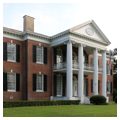Built for Lyman and Elizabeth Harding, Auburn introduced academic architecture to the Mississippi Territory. Architect Levi Weeks (1776–1819) described the mansion in an 1812 letter. "The brick house I am building. . . . is designed for the most magnificent building in the Territory. The body of this house is . . . two stories with a geometrical staircase to ascend to the second story. This is the first house in the Territory on which was ever attempted any of the orders of Architecture."
Auburn was originally a five-bay symmetrical brick building with a hipped roof and a three-bay portico. The giant-order Roman Ionic columns of the portico support a full molded entablature with modillioned cornice that encircles the house. The upper and lower doorways are crowned with semicircular fanlights echoed in the tympanum of the pediment by an oval light with radiating muntins. Marble keystones are centered over doorways and windows, and the windows that open onto the portico are floor-length. Sheltered by the rear gallery, the original penciled mortar joints of the Flemish-bond brickwork remain visible.
Auburn’s portico was one of the earliest giant-order porticoes in the nation; it was immediately influential and copied throughout the South. It predates the giant-order columns added to the White House (1820s) in Washington, D.C., and to Arlington House (1818) in Virginia. Although the portico was ahead of its time, the exuberant interior Georgian millwork was old-fashioned. A doorway with swan's neck pediment derives from Plate XXVI of William Salmon's 1734 Palladio Londinensis, and a doorway with broken pediment and shell cartouche comes from William Paine's 1758 Builder's Companion. The circular stair appears in Paine's British Palladio (1786).
In 1827, Stephen Duncan and his wife, Catherine, purchased Auburn. One of the South’s most successful cotton planters, Duncan owned approximately 1,000 slaves by the 1850s on his eleven plantations in Mississippi and Louisiana. Auburn was the Duncans’ suburban retreat, where they probably had no more than 30 enslaved workers. About 1840, Duncan added recessed symmetrical wings and a rear colonnade to Auburn, and updated the interior with marble mantelpieces. Surviving antebellum outbuildings include a two-story brick kitchen building with slave quarters on the second story, a rare one-story temple-form frame billiard hall, a one-story brick dairy, and a brick carriage house/barn.
In 1911, Duncan heirs deeded Auburn and its associated acreage to the City of Natchez to be used as a public park, a use it retains today.




